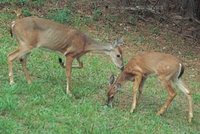Autumn Songs: Northern Mockingbirds and Carolina Wrens
Wednesday, September 26th, 2007At 7:30 this morning, the air felt pleasantly warm and humid. Big soft gray clouds covered much of the sky, but in a loose, sleepy way, so that the sky looked mostly blue, and the sun rose clear and silver-yellow, burning away the clouds as it rose higher. Dew dampened the grass, and as I walked, big fat raindrops spattered down for several minutes, spotting the road, but never enough even to get me wet.
Several Mockingbirds have begun to sing throughout the neighborhood, so at times it sounds like a recap of the summer, a medley of Red-eyed Vireo, Tufted Titmouse, Blue-gray Gnatcatcher, Summer Tanager, Great-crested Flycatcher, Yellow-throated Vireo, Wood Thrush, and even Chuck Wills Widow. One Brown Thrasher also was singing this morning, as well as three Phoebes and several Carolina Wrens. Four Bluebirds sat in the bare top branches of four different pecan trees along the roadside and warbled. A Catbird mewed in the Old Field, but the White-eyed Vireos have been silent – and presumably gone – now for several days.
As I passed the Old Field, a Carolina Wren sang from the thickets, winkery-winkery-winkery-weep, and another, across the road on the other side of me, responded, jubilee-jubilee-jubilee-chee. Almost the same song, but not the same – one sounded more “chewy” while the other was sharper and more metallic. Then I heard yet another singing the same kind of repeated three syllable pattern, that was more like the classic description of a Carolina Wren’s song, teakettle, teakettle, teakettle, tea! Basically the same, but distinctly different versions.
In this part of the South, Carolina Wrens are so common we often take them for granted. Small, pugnacious brown birds with upturned tail, down-curving bill, and a white stripe over the eye, they always seem full of energy. They’re familiar to many of us as the pesky little birds that are always trying to build a nest in a hanging fern or a box in the garage, or even on top of a wheel on a truck if it hasn’t been driven in a while. One of my favorite descriptions of a Carolina Wren is given by A.C. Bent, quoting a Mr. Dawson, who wrote in 1903: “On all occasions this nervous little creature appears to be full of a sort of compressed air, like the lid of a teakettle being jarred up and down by steam.”*
As common as they are, Carolina Wrens are among the most musical and virtuosic of all birds, and at this time of year, I’m always reminded of their amazingly varied and extensive repertoire of songs, calls, and other sounds like buzzy scolding, or alarm chirping or – especially in the fall – a sort of traveling, burbling call used as they move through bushes and low trees. Their most characteristic song is two or three syllables, repeated several times, but there seem to be an almost endless number of variations on a few basic patterns. At times, I have stood in one spot and heard as many as eight different Carolina Wrens singing eight distinctly different songs around me – some two-syllable, some three – and it was impossible not to wonder what different meanings their songs might be expressing.
*A.C. Bent, Life Histories of North American Birds. Carolina Wren (Thryothorus ludovicianus)
